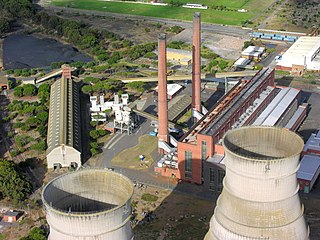
A power station, also referred to as a power plant and sometimes generating station or generating plant, is an industrial facility for the generation of electric power. Power stations are generally connected to an electrical grid.

A combined cycle power plant is an assembly of heat engines that work in tandem from the same source of heat, converting it into mechanical energy. On land, when used to make electricity the most common type is called a combined cycle gas turbine (CCGT) plant. The same principle is also used for marine propulsion, where it is called a combined gas and steam (COGAS) plant. Combining two or more thermodynamic cycles improves overall efficiency, which reduces fuel costs.

Cogeneration or combined heat and power (CHP) is the use of a heat engine or power station to generate electricity and useful heat at the same time. Trigeneration or combined cooling, heat and power (CCHP) refers to the simultaneous generation of electricity and useful heating and cooling from the combustion of a fuel or a solar heat collector. The terms cogeneration and trigeneration can also be applied to the power systems simultaneously generating electricity, heat, and industrial chemicals.
Puget Sound Energy (PSE) is an energy utility based in the U.S. state of Washington, providing the Puget Sound region with electrical power and natural gas. The utility serves electricity to more than 1.1 million customers in Island, King, Kitsap, Kittitas, Pierce, Skagit, Thurston, and Whatcom counties, and provides natural gas to 750,000 customers in King, Kittitas, Lewis, Pierce, Snohomish and Thurston counties. The company's electric and natural gas service area spans 6,000 square miles (16,000 km2).

The Richard L. Hearn Generating Station is a decommissioned electrical generating station in Toronto, Ontario, Canada. The plant was originally fired by coal, but later converted to burn natural gas. The plant has been described as "Pharaonic in scale", and encompasses 650 thousand cubic metres of space—large enough to fit 12 Parthenons inside.

The Portlands Energy Centre is a 550-megawatt natural gas electrical generating station in Toronto, Ontario. It is located in the Port Lands area of the Toronto waterfront at 470 Unwin Avenue, adjacent to the site of the decommissioned Hearn Generating Station.

Peaking power plants, also known as peaker plants, and occasionally just "peakers", are power plants that generally run only when there is a high demand, known as peak demand, for electricity. Because they supply power only occasionally, the power supplied commands a much higher price per kilowatt hour than base load power. Peak load power plants are dispatched in combination with base load power plants, which supply a dependable and consistent amount of electricity, to meet the minimum demand.

The Osborne Power Station is located in Osborne, a northwestern suburb of Adelaide, South Australia.
Ontario electricity policy refers to plans, legislation, incentives, guidelines, and policy processes put in place by the Government of the Province of Ontario, Canada, to address issues of electricity production, distribution, and consumption. Policymaking in the electricity sector involves economic, social, and environmental considerations. Ontario's electricity supply outlook is projected to deteriorate in the near future due to increasing demand, aging electricity supply infrastructure, and political commitments, particularly the phase-out of coal-fired generation. Policymakers are presented with a range of policy choices in addressing the situation, both in terms of overall system design and structure, and specific electricity generating technologies.
Part of Westinghouse Electric Corporation's Westinghouse Power Generation group, the Westinghouse Combustion Turbine Systems Division (CTSD) was originally located, along with the Steam Turbine Division (STD), in a major industrial manufacturing complex, referred to as the South Philadelphia Works, in Lester, PA near to the Philadelphia International Airport.

King's Lynn Power Station is a combined cycle natural gas power station near King's Lynn in Norfolk, commissioned in 1997, and now owned by Centrica Energy. It was mothballed on 1 April 2012. It can generate 325 MW of electricity and employed 40 people. The site was reopened on 19 November 2019.

Spalding Power Station is a 860 MW gas-fired power station one mile north of Spalding on West Marsh Road close to the River Welland. The current site provides enough electricity for one million households.

Thor Cogeneration is a planned, but undeveloped, gas-fired cogeneration plant, which was to be built on Seal Sands near Billingham, in County Durham, North East England.
Cory Cogeneration Station is a natural gas-fired station owned by SaskPower and located near Saskatoon, Saskatchewan, Canada. The plant operates at 260 MW in a conventional generation mode and at 228 MW in a cogeneration mode. Steam from the plant is used to supply the Potash Corp Cory Mine.
Island Generating Station is a natural gas-fired station owned by Capital Power Corporation, in Campbell River, British Columbia, Canada. The plant operates as a co-generation facility under a 20-year power purchase agreement with BC Hydro while steam is supplied to Elk Falls Mill.
GTAA Cogeneration Plant is a combined cycle natural gas and steam power station owned by the Greater Toronto Airports Authority, in Mississauga, Ontario. The plant is primarily used to supply steam and power to the Toronto Pearson International Airport with surplus power sold onto the Ontario grid. The plant is located across from the airport at Elmbank Road and Network Road next to the Central Utilities Plant.
Sarnia Regional Cogeneration Plant is a natural gas power station owned by TransAlta Energy, in Sarnia, Ontario. The plant is primarily used to supply steam to Arlanxeo, Styrolution, Suncor and Nova Chemicals and power onto the Ontario Grid.
Brighton Beach Generating Station is a natural gas fired combined cycle fossil fuel power station in the Brighton Beach neighbourhood of Windsor, Ontario, Canada that is a 50% joint venture between Atco Power and Ontario Power Generation. The electricity generated is under the control and marketing lead of by Coral Energy Canada Inc. Gas for the plant is supplied by Union Gas, and cooling water is drawn from the Detroit River.










